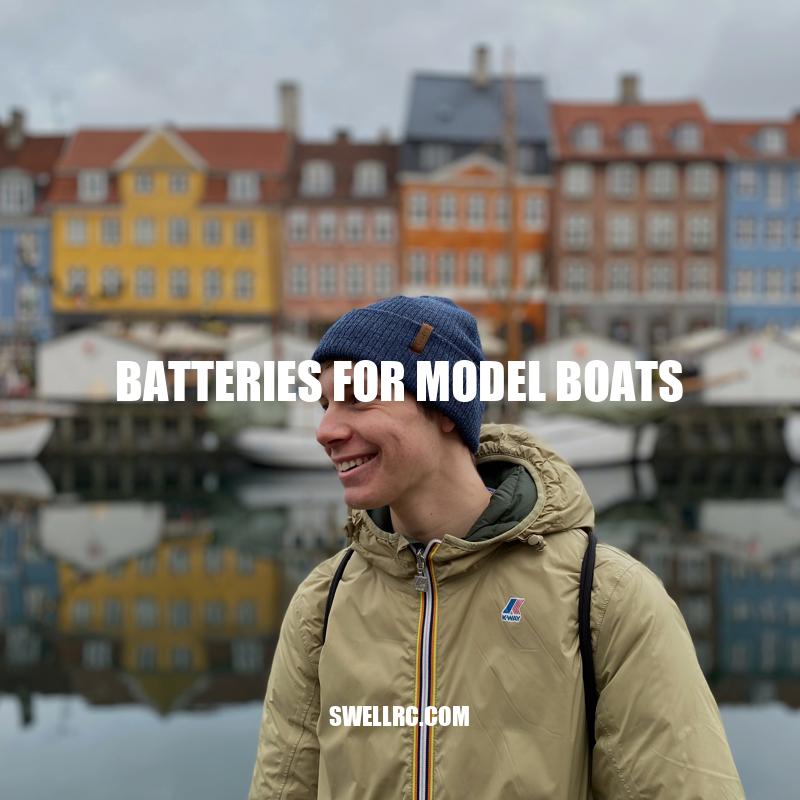Batteries for Model Boats: Choosing the Right Marine Battery
Batteries play a crucial role in powering model boats. They provide electrical energy to the boat’s motor, propelling it through the water, and are essential components for any boater who enjoys spending time on the water. Choosing the right battery for your model boat can be overwhelming, especially for a beginner. With so many battery types, sizes, and chemistries available on the market, it’s essential to understand the power requirements of your boat and the benefits and drawbacks of each type of battery. This article provides a comprehensive guide to help you choose the best batteries for your model boats. We will discuss the different types of batteries, their pros and cons, factors to consider when choosing a battery, and battery safety tips to keep in mind. With this information, you can make an informed decision and enjoy your model boat without worrying about battery issues.
Types of batteries for model boats
There are various types of batteries for model boats, including:
- Lithium Polymer (LiPo) batteries: These are lightweight, high-performance batteries that are commonly used in model boats. They are available in various capacities and cell configurations and are suited for high-power applications. However, they can be volatile if not handled and charged correctly.
- Nickel-Metal Hydride (NiMH) batteries: These are rechargeable batteries that offer a good balance between cost, performance, and safety. They are easy to maintain and can be charged using a standard charger. NiMH batteries have lower energy density than LiPo batteries and are best suited for low to medium-power applications.
- Lead-acid batteries: These are heavy, bulky batteries commonly used in larger model boats that require a lot of power. They have a high capacity and can provide consistent power to the boat’s motor. Lead-acid batteries are the least expensive option but require more maintenance and can be challenging to transport due to their weight.
When selecting a battery for your model boat, consider the size and weight of your boat, the speed and power requirements, and the maximum run time you need. You should also consider the charger compatibility, the availability of spare parts, and the battery’s price. You can find a wide variety of model boat batteries at Amazon, HobbyKing, and Banggood. Some popular online retailers for batteries for model boats include these retailers.
What are the 2 common types of batteries used in marine?
When it comes to marine batteries, there are two common types that are used on boating trips. Understanding the differences between the two can help you make the best choice for your vessel.
The first type of battery commonly used in marine applications is the Flooded Lead Acid Battery. This type of battery features lead plates immersed in a liquid electrolyte solution that allows for energy to be stored and released as needed. Flooded batteries require maintenance and monitoring, as the electrolyte levels must be checked and topped off periodically. However, they are known for their durability and longevity, making them a popular choice among seasoned boaters.
The second type of battery commonly used in marine applications is the Absorbed Glass Mat (AGM) Battery. This type of battery uses a thin fiberglass mat to absorb the electrolyte solution, eliminating the need for periodic maintenance. AGM batteries also have the advantage of being spill-proof, vibration-resistant and able to deliver high currents on demand, making them ideal for high-performance marine applications.
Overall, the choice between these two types of batteries will depend on your personal boating needs and preferences. It is important to conduct thorough research and consult with a marine battery expert before making a purchase.
Battery capacity and voltage
Battery capacity and voltage are crucial factors to consider when selecting batteries for model boats. Here are a few things to keep in mind:
- Battery capacity is measured in milliampere-hours (mAh) and determines how long the battery can power your boat before needing a recharge. The greater the capacity, the longer the run time.
- The battery’s voltage determines the power output and ultimately affects the speed and performance of the boat. Most model boats run on 6-12 volts, while larger boats may require up to 24 volts.
- You can calculate the right battery capacity and voltage for your model boat by using the following formula: Capacity (mAh) = (Current Consumption (A) x Running Time (h) )/ Efficiency (%)
Here’s a table of estimated battery capacities and run times for small to medium-sized model boats:
| Boat Size | Estimated Battery Capacity (mAh) | Estimated Run Time (min) |
|---|---|---|
| Mini (less than 18 inches) | 500-1500 | 5-12 |
| Small (18-24 inches) | 1500-2500 | 12-20 |
| Medium (24-36 inches) | 2500-5000 | 20-40 |
Calculating the right battery capacity and voltage is critical to ensure optimal performance and run time for your model boat. You can find battery calculators and online battery selectors that can help you determine which battery is right for your boat. Several marine supply stores and online retailers like HobbyKing and Amazon have battery guides and calculators that can assist you in selecting the perfect battery for your model boat.
How do I know what battery my boat needs?
To determine the right battery for your boat, you need to consider a few things. First and foremost, it’s crucial to ensure that you purchase a marine battery, which is specifically designed for boats. Marine batteries are built to withstand the demands of the marine environment, including corrosion and vibration, among other things.
Once you’ve determined that you need a marine battery, you need to decide what type of battery you require. There are three primary types of marine batteries: starting batteries, deep cycle batteries, and dual-purpose batteries. Starting batteries are designed to deliver a quick burst of power to start your engine, while deep cycle batteries provide sustained power over a more extended period, making them ideal for running electronics, trolling motors, and other devices onboard. Dual-purpose batteries, as the name suggests, offer a combination of both starting and deep cycle capabilities.
The next thing to consider is the size (group size) of the battery. The group size is determined by the physical size and terminal location of the battery, which varies from boat to boat. To determine the right group size, consult your boat’s manual or consult with a professional.
Battery capacity is another essential consideration. The capacity refers to the amount of energy the battery can store and is measured in amp-hours (Ah). The capacity you require depends on the amount of power your boat’s electrical system needs and the length of time you plan to spend on the water. Generally, the bigger the boat, the more capacity you’ll need.
In conclusion, choosing the right battery for your boat requires careful consideration of several factors, including marine-specific design, battery type, group size, and capacity. Taking the time to evaluate these needs will help ensure that you have a reliable and efficient power source for your boating adventures.
Battery safety
Ensuring battery safety should be a top priority when using batteries for model boats. Here are some essential safety tips to follow:
- Always handle batteries with care and using the correct protective gear to avoid accidents.
- Never store batteries in extreme temperatures, as this can cause them to explode or leak hazardous chemicals.
- It is crucial to use chargers that are compatible with the type of battery you are using.
- Always fully charge batteries before use, as partially charged batteries may not perform adequately.
- Dispose of batteries properly – never throw batteries in the trash as they contain hazardous materials. Recycle batteries at a proper recycling facility or take them back to the manufacturer if possible.
By following these tips, you can keep your model boat battery safe and reduce the risk of accidents or environmental damage.
Several online marine supply stores like West Marine and Defender offer extensive resources on battery safety and handling. You can also find safety information on battery manufacturer websites like Duracell and Energizer. It is essential to regular check the battery and replace it if you notice any signs of damage or wear to avoid any accidents.
What kind of battery is best for a boat?
When choosing a battery for your boat, it’s important to select one that is specifically designed for marine use and can handle the demands of the aquatic environment. The best type of battery for your boat will depend on the size of your vessel and the types of electronics and accessories you have installed on board.
Most boats use lead-acid batteries as they are reliable and relatively affordable. However, there are different types of lead-acid batteries to consider. Flooded lead-acid batteries are the most common and least expensive, but they require regular maintenance and can spill if tipped over. Sealed lead-acid batteries, on the other hand, are maintenance-free and can be mounted in any position, making them a popular choice for smaller boats.
For larger vessels or for boats with high electrical demands, deep-cycle batteries are a good option. These batteries are specifically designed to handle prolonged discharges and recharges, making them ideal for running electronics and other heavy-duty equipment.
Another factor to consider is the battery’s amp-hour rating, which indicates how long the battery can run before needing recharging. In general, the higher the amp-hour rating, the longer the battery will last on a single charge.
Regardless of the type of battery you choose, be sure to properly install and maintain it to ensure optimal performance and safety on the water.
Battery maintenance
Proper battery maintenance is essential for maximum battery life and performance. Here are some useful tips to keep your model boat battery in top shape:
- Store your batteries in a cool, dry place away from direct sunlight and extreme temperatures.
- Don’t let your batteries drain completely, as this can reduce their life span. Always store them partially charged.
- Charge your batteries before you plan to use them. For optimal performance, charge them the night before you plan to take your boat out on the water.
- Use a smart charger that automatically detects when your battery fully charged to avoid overcharging.
- Regularly check the battery for any signs of damage like bulging, leaking, or discoloration, which may indicate the need for a replacement.
By following these simple maintenance tips, you can ensure that your battery remains in peak condition for optimal performance throughout its life span.
Several online resources such as Battery University and the Battery Council International offer detailed information on battery maintenance and care. Marine supply stores that sell batteries like Walmart and Amazon offer a range of battery maintenance products such as battery chargers, cleaning agents, and testers that can help prolong battery life. With a little care and attention, your model boat battery will deliver reliable performance for years to come.
Do marine batteries need maintenance?
Marine batteries are incredibly vital for your boat’s performance as they power up navigation systems, lights, and other electronics on board. The last thing you want is a dead battery while out at sea. However, maintenance is required to ensure that these batteries work efficiently and don’t become a liability.
The first step to maintaining your marine battery is to check its water levels routinely. Like any other battery, marine batteries have water in their cells and get depleted with time. Low water levels can damage the battery permanently, so ensure that you check the water levels frequently and top up as needed.
It’s also important to keep your marine battery clean. Clean the terminals and connectors regularly and ensure that they’re free from any corrosion. The corrosion can affect the battery’s ability to charge and discharge efficiently, which can result in a shorter lifespan.
Another critical aspect of maintaining your marine battery is ensuring that it’s charged frequently. Remember, marine batteries lose their charge over time, even when not in use. Ensure that you charge the battery before and after your boating trips.
Finally, it’s worth investing in a good quality battery charger to maintain the battery’s charge levels when not in use. These chargers help prevent overcharging, which can damage the battery, and also provide a trickle charge to keep the battery topped up.
In conclusion, marine batteries require maintenance to ensure longevity and efficiency. Regular checks of the water levels, cleaning the terminals and connectors, charging and investing in a good quality battery charger are some of the steps that are necessary to keep your marine battery in excellent condition.
Choosing the right battery for your model boat depends on several factors. Here are some aspects to consider before making a purchase:
- Boat size: The size and weight of your model boat should dictate the size and capacity of your battery.
- Power system: Different types of power systems, such as brushed and brushless motors, require different batteries for optimal performance.
- Intended Use: Will you be using your boat for leisurely cruising or high-speed racing? The intended use of your boat will help you determine the type of battery you need.
- Budget: Batteries come in different price ranges, and the more advanced batteries can be costly. Decide on a budget that works for you and look for batteries that fit your budget.
To help determine the best battery for your model boat, you can consult the manufacturer’s recommendations or ask for advice from experienced model boat enthusiasts or dealers. Some popular brands that offer batteries for model boats include Traxxas, Venom, and Proboat.
Additionally, you can find batteries and other accessories for model boats at hobby shops, marine supply stores, and online retailers such as Amazon, HobbyKing, and Tower Hobbies. When purchasing batteries, always make sure to buy from reputable sellers to ensure that you receive a quality product that suits your needs.
Conclusion
In conclusion, choosing the right battery for your model boat is key to achieving optimal performance and safety on the water. Consider the size and weight of your boat, the power system you are using, the intended use of your boat, and your budget when selecting a battery type and capacity. Remember to also prioritize battery safety and maintenance to ensure a long lifespan for your batteries.
When shopping for model boat batteries, do your research and buy from reputable sellers to ensure that you receive a high-quality product that suits your needs. With the right battery and proper care, you’ll be able to enjoy many hours of boating fun.
Lastly, keep in mind that technology is always improving, and new and better batteries are being developed. As such, it is a good idea to stay informed and keep an eye out for new advancements in marine batteries that may improve the performance of your model boat.
Remember, proper battery selection, care, and maintenance are all crucial in ensuring that your model boating experience is a success. Make sure to follow the recommendations and advice offered here to ensure that your battery is up to the challenge of powering your model boat.



